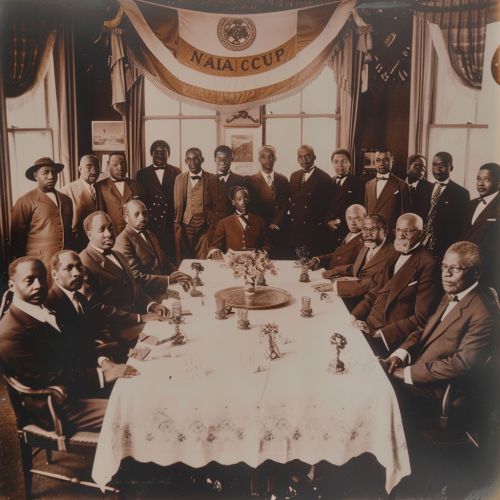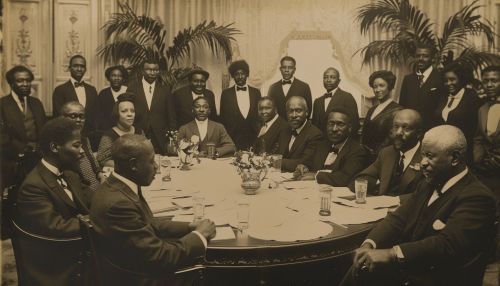National Association for the Advancement of Colored People
History
The National Association for the Advancement of Colored People (NAACP) was founded on February 12, 1909, in response to the ongoing violence against African Americans around the country. The organization was established by a diverse group of activists, including W.E.B. Du Bois, Mary White Ovington, and Moorfield Storey. The NAACP's mission was to ensure the political, educational, social, and economic equality of rights of all persons and to eliminate racial hatred and racial discrimination.
The NAACP's early efforts focused on legal strategies designed to confront the critical civil rights issues of the day. One of the organization's first major legal victories came in 1915 with the Supreme Court case Guinn v. United States, which struck down grandfather clauses that had been used to disenfranchise African American voters.


Organizational Structure
The NAACP is structured with a national office, regional offices, and local branches. The national office, headquartered in Baltimore, Maryland, oversees the organization's overall strategy and operations. The regional offices coordinate activities within their respective areas, while local branches implement the NAACP's programs and initiatives at the community level.
The NAACP's leadership includes a Board of Directors, which sets policy and direction for the organization, and an Executive Director, who manages day-to-day operations. The Board is composed of elected members from various regions and sectors, ensuring diverse representation.
Key Campaigns and Initiatives
Legal Defense and Educational Fund
The NAACP's Legal Defense and Educational Fund (LDF) was established in 1940 under the leadership of Thurgood Marshall. The LDF became a separate entity in 1957 but continues to collaborate closely with the NAACP. The LDF's primary focus is on achieving racial justice through litigation, advocacy, and public education.
One of the most significant achievements of the LDF was the landmark Supreme Court case Brown v. Board of Education in 1954, which declared state laws establishing separate public schools for black and white students to be unconstitutional.
Voter Rights
The NAACP has been at the forefront of the struggle for voting rights for African Americans. The organization played a crucial role in the passage of the Voting Rights Act of 1965, which aimed to overcome legal barriers at the state and local levels that prevented African Americans from exercising their right to vote.
The NAACP continues to fight against voter suppression through litigation, advocacy, and grassroots mobilization. Recent efforts have focused on combating voter ID laws, gerrymandering, and other tactics that disproportionately affect minority voters.
Economic Opportunity
The NAACP works to promote economic opportunity for African Americans through various programs and initiatives. The organization advocates for fair employment practices, equal pay, and access to quality education and training. The NAACP also supports minority-owned businesses and works to eliminate barriers to economic advancement.
Major Events and Milestones
The Great Migration
During the early 20th century, the NAACP played a significant role in supporting African Americans who migrated from the rural South to urban areas in the North and West. This movement, known as the Great Migration, saw millions of African Americans leave the oppressive conditions of the South in search of better opportunities.
The NAACP provided legal assistance, advocated for fair housing, and worked to address the challenges faced by African Americans in their new communities.
Civil Rights Movement
The NAACP was a key player in the Civil Rights Movement of the 1950s and 1960s. The organization was involved in numerous protests, boycotts, and legal battles aimed at ending segregation and discrimination. Notable events include the Montgomery Bus Boycott, the March on Washington, and the Selma to Montgomery marches.
The NAACP's efforts during this period helped to bring about significant legislative changes, including the Civil Rights Act of 1964 and the Fair Housing Act of 1968.
Challenges and Controversies
Over the years, the NAACP has faced various challenges and controversies. The organization has had to navigate internal conflicts, financial difficulties, and criticism from both within and outside the African American community. Despite these challenges, the NAACP has remained a steadfast advocate for civil rights and social justice.
One notable controversy involved the organization's stance on affirmative action. While the NAACP has historically supported affirmative action policies as a means of addressing systemic discrimination, the issue has been a point of contention both within the organization and in the broader public discourse.
Current Activities and Future Directions
Today, the NAACP continues to address a wide range of issues affecting African Americans and other marginalized communities. The organization focuses on areas such as criminal justice reform, health equity, environmental justice, and education.
The NAACP's current initiatives include the "NAACP Forward" strategic plan, which aims to build sustainable communities, increase civic engagement, and advance social justice. The organization also leverages technology and social media to engage with younger generations and amplify its message.
